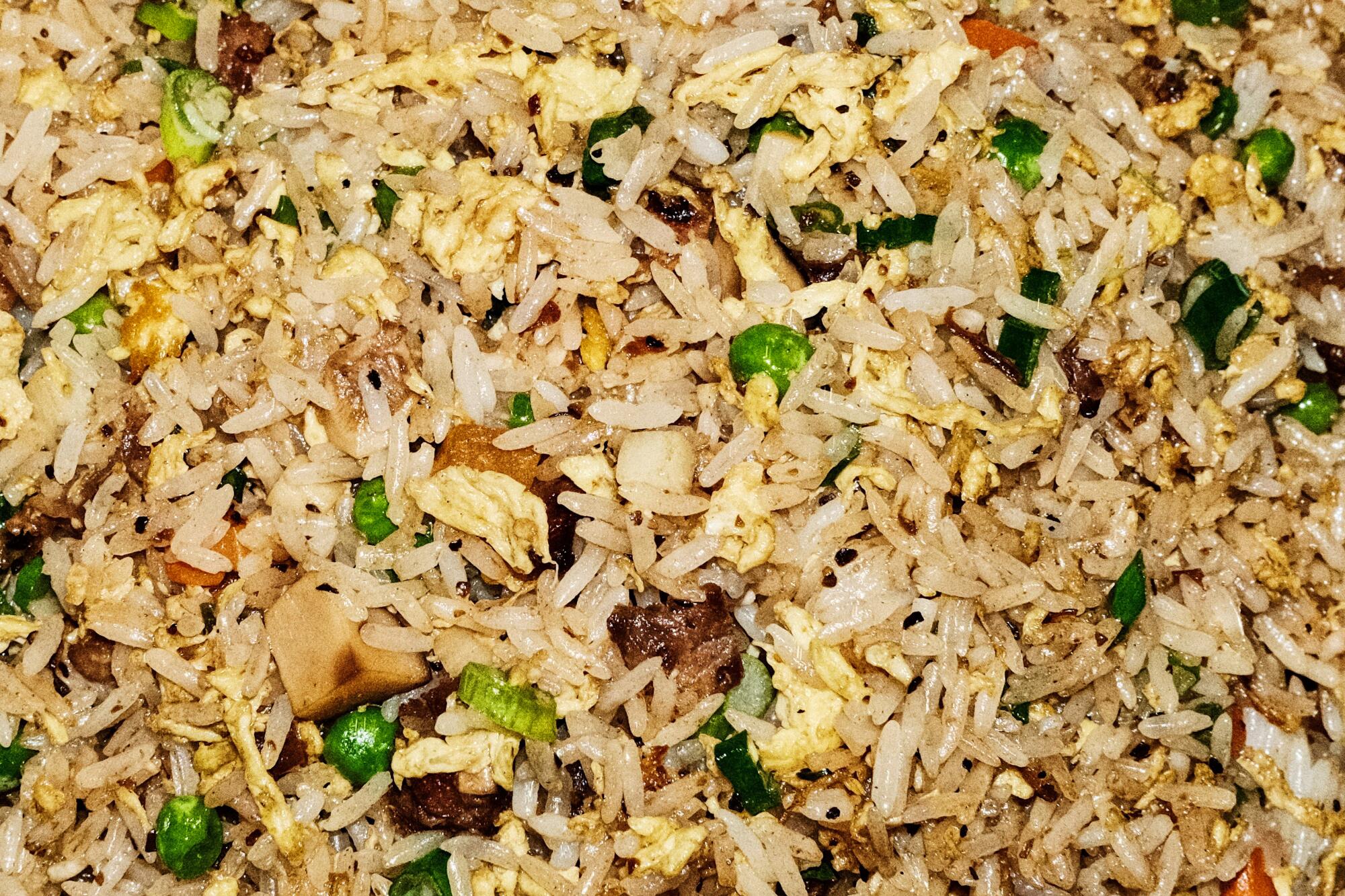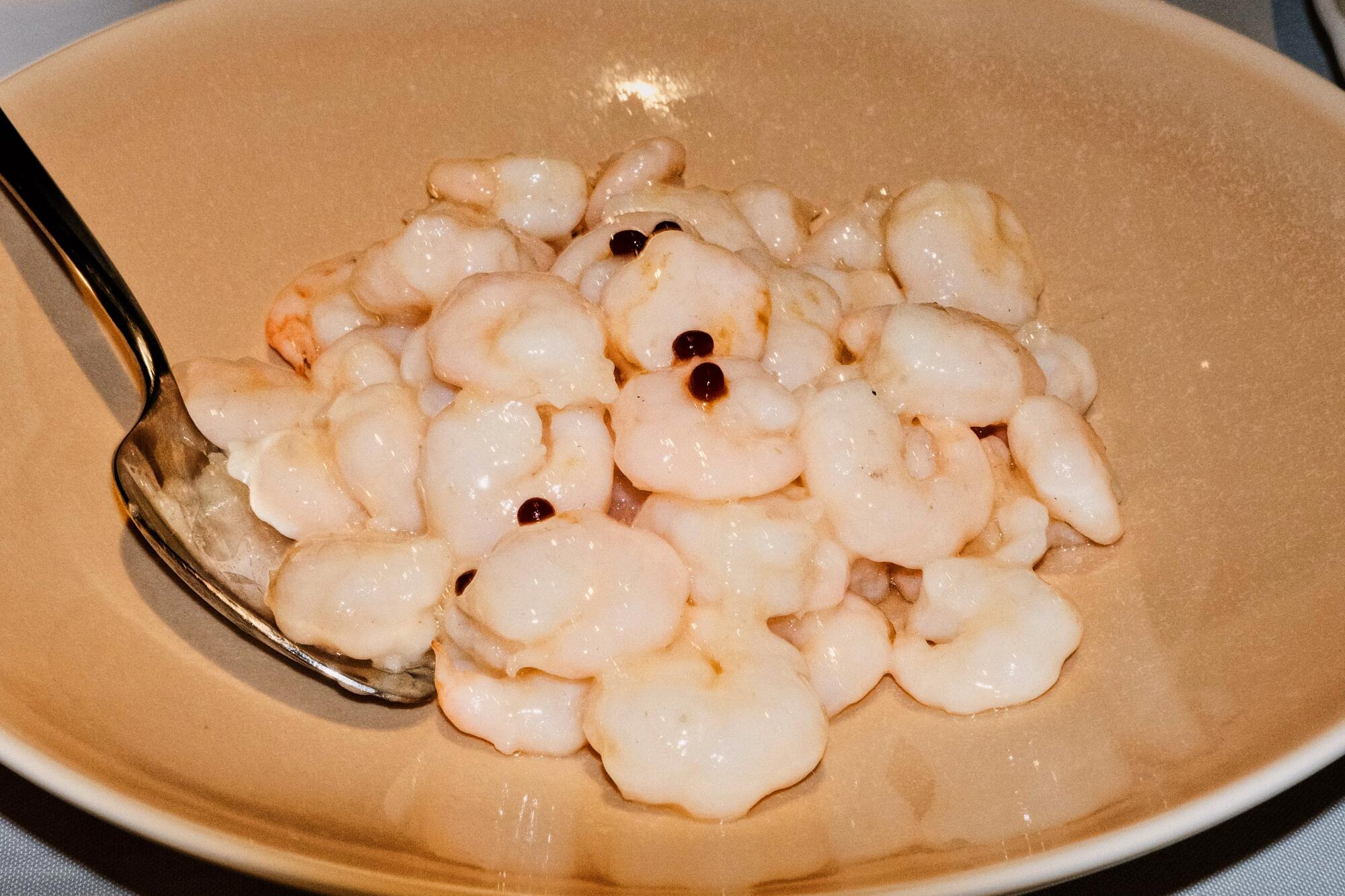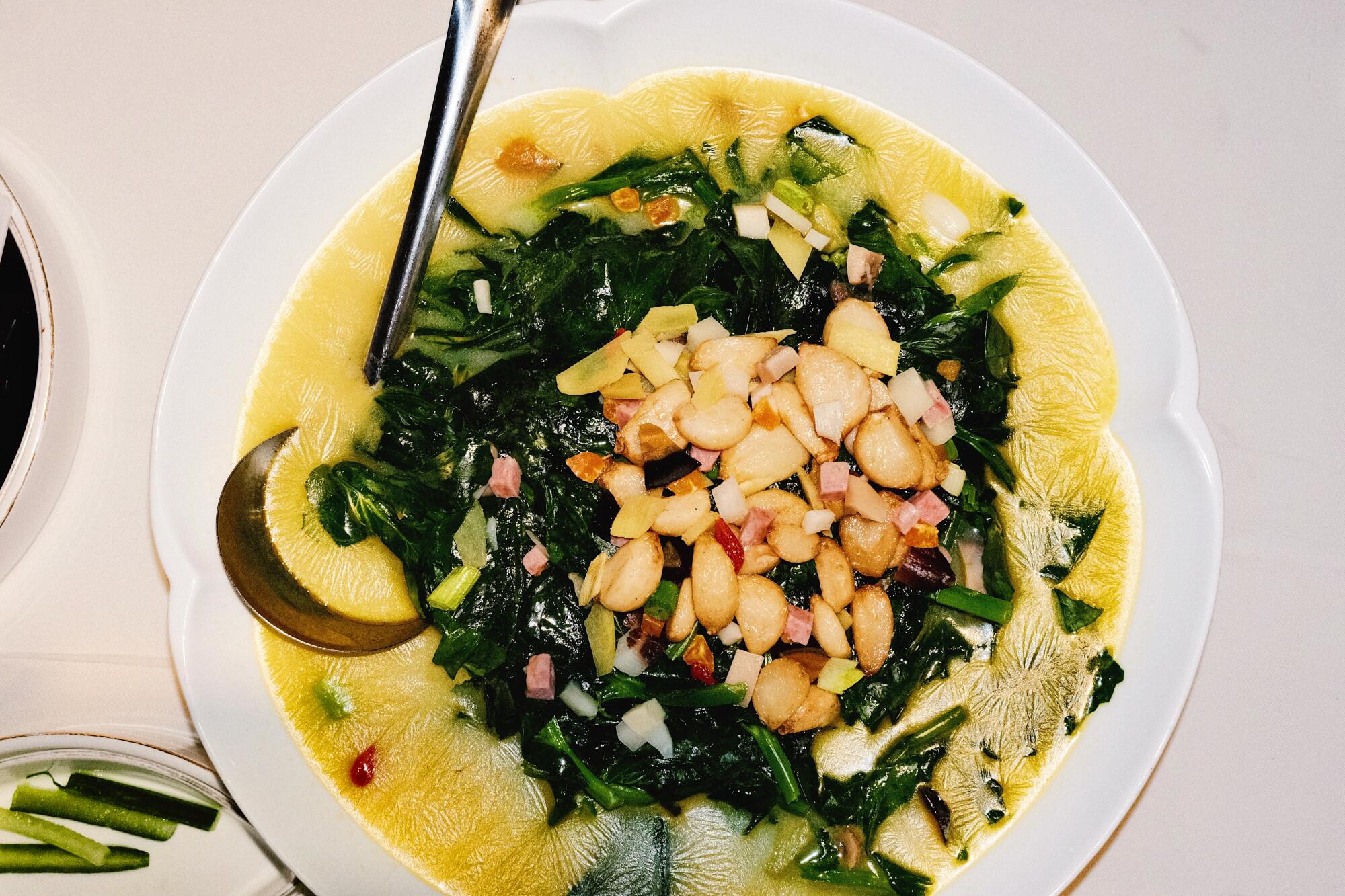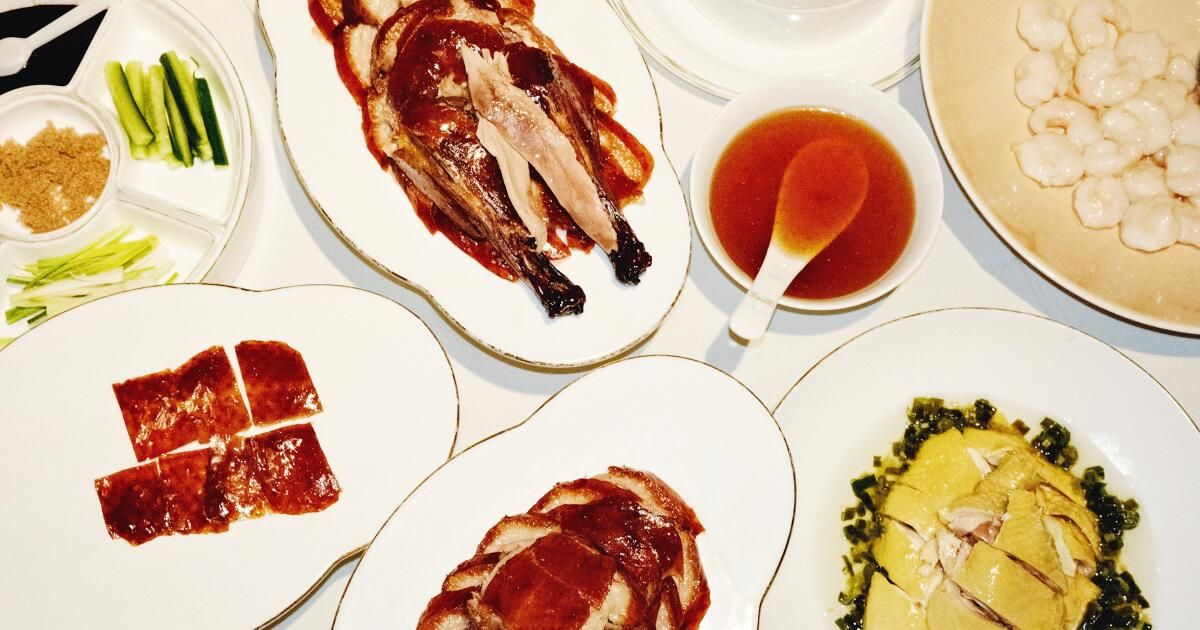No matter the culture, whatever the era, primal human wiring governs one truism: When a chef rolls a cart into a dark dining room and theatrically sets the food on fire, heads will turn in all directions.
At Array 36, an upscale Chinese restaurant in Temple City with a fantastic multimillion-dollar design, the flambéed focal point is a lacquered whole duck. The roasted bird hangs from a hook protruding from the mouth of a swirling gold-painted dragon sculpture.
A chef pours erguotou (a clear variation on the Beijing-style liquor called baijiu distilled from sorghum and wheat), then aims a butane torch… and bam! Yellow and blue flames burst and rise for a few dramatic seconds. The fire-breathing metallic beast smiles at the flickering glow.
The roast duck arrives at the table, theatrically set on fire.
(Stephanie Breijo / Los Angeles Times)
Then the flames go out and the chef gets to work. First: a small plate of crispy, diced skin, which must first be dipped in brown sugar found in the center of a condiment tray. Next comes a pile of boneless slices of meat, adorned with more skin. A waiter delivers crepe-thin pancakes to wrap the duck with hoisin spreads and scallion and cucumber sticks.
Finally, the chef cuts a second plate of meat on an oval pedestal and places it on a glass bell prepared for smoked infusions. The content disappears into a cloud.
Half a minute later, the waiter brings the container to the table and lifts it from the dome, swirling the vapors. The duck has enough campfire perfume. We have disappeared so deeply into the spell of the feast that we almost forget to thank the chef for the performance before the cart moves on.
The “fire show,” as Array 36 staff sometimes call the English presentation, is in high demand.
Diners make reservations here the old-fashioned way: calling the restaurant is the only option, and anyone who wants the whole duck must order it in advance and hope that the limited number of ducks per night (about 20, I'm told) still runs out. has been assigned.
No other garnish on the table matches its extravagance, and the duck is consistent in its deliciousness, but overall, Array 36 aims for a kind of performative extravagance. Shanghai native Tony Tao oversees an extensive menu that leans toward the cuisine of Shanghai and the surrounding Jiangnan region, but also delves at will into Cantonese and Sichuan specialties and imagined dimensions beyond. It's possible to order an excellent variety, but I learned through trial and error over several meals that included disappointment.
Friends with family connections across mainland China who joined me for lunch or dinner noted that this style of restaurant sounds familiar: a luxurious haven meant as much to impress business associates as it is to celebrate personal occasions, lined with dining rooms. privates of different sizes and ornate decorations for high rollers.
The main space falls somewhere between ornate and jaw-dropping in its ambience. Muscle opens the thick golden doors of the restaurant and enters a lobby where piano music descends from above in calm, unique tones. Without a doubt, she feels like entering a spa.

Pressed Japanese jellyfish head with yuzu infusion.
(Stephanie Breijo / Los Angeles Times)

A swimming whale, projected on a curtain at the restaurant entrance.
(Stephanie Breijo / Los Angeles Times)
To the right, behind the host's desk, mounted stone slabs glow the orange-red hue of erupting lava straight out of an Indiana Jones adventure. Fog rises from below like volcanic steam. Two wall-sized screens project a lone blue whale swimming in an endless loop. Another shape resembles a unicorn with droopy, cartoonish flesh.
Clusters of fake but truly realistic plants and patches of moss dot the room's landscape. A silver sculpture sinks and rotates almost along the ceiling. Does it look like a roller coaster? The winding path of a comet? A dull deity doodling at the margins of space and time? You look up from a table, forearms resting on a starched white cloth, and wonder.
Then you go back to studying pages and pages of dishes.
Some strategic tips from experience: Focus less on dumplings and bao and more on stews, fresh seafood and seasonal vegetables. I'm generally a fan of Shanghainese-style appetizers, but the cold poached chicken in scallion oil lacks seasoning and the smoked fish with preserved plums is much sweeter than smoked, although a friend from the region noted that the deep-fried texture almost sandy The fish was correct and punctual.
I'd rather start with soup, which I also found uneven: one listed on the regular menu, balanced by stewed chicken with dried scallops and julienned cordyceps; yes, the mushrooms that went rogue in “The Last of Us”; None of us became clickers: we were disappointed with the thinner, milder broth.
During a later dinner, a Cantonese friend was given a page of special offers written only in Chinese characters (and if you know it, servers will be happy to provide it and translate it). He listed a whole chicken soup, which arrived in a tureen large enough for a crowd and possessed the silky, poultry-rich broth he had previously hoped for.
For individual portions, the special menu also mentions individual lion's head dumplings, paler than others I've had locally but deftly fluffy and intricately spiced, nestled in a ladle of the same intense broth.

The fried rice is sprinkled with vegetables and egg.
(Stephanie Breijo / Los Angeles Times)

The stir-fried river prawns did not appear to be those tiny specimens, but were served with a splash of vinegar and bit into with satisfaction.
(Stephanie Breijo / Los Angeles Times)
It's no coincidence that my best meal at Array 36 occurred with a group of six people, including some especially skilled tacticians at ordering Chinese meals that achieve maximum variety and harmony. We savored the snap of sautéed “river shrimp,” although they were not technically those tiny specimens, especially with a taut dose of vinegar with which they were served.
Among a rotating selection of fresh seafood, the only option of the night was turbot, which we ordered Cantonese style, steamed with ginger and scallions. The fish was as delicate and infused with fragrance as any version I've had in Los Angeles.
The “Shanghai Signature Braised Pork Belly,” named among several variations on the theme, closely resembled hong shao rou, the red-braised pork belly famous in the region, which is crispy, aromatic and almost syrupy due to the dark soy sauce, ginger, garlic and the pronounced licorice pinch of star anise.
“Sichuan-style slow-cooked French beef ribs” turned out to be a modified version of a standard at local Meizhou Dongpo restaurants. The meat was sliced on the bone and spread across four sauces, including tingling powdered spices, oil doused with minced garlic and ginger, and a mild green chile sauce. The staging seemed gimmicky, but the meat had been cured, so the flavor was distantly and satisfyingly reminiscent of pastrami, and it was a fun topic of conversation.
Possibly my favorite dish: sweet, earthy pea leaves served in broth, topped with roasted garlic cloves and chopped pieces of ham, preserved egg and chives. This broth had also been simmered to smoothness, with poultry undertones that tied together the disparate flavors of the garnish.

Pea leaves in broth, with garnishes including roasted garlic cloves, ham, preserved egg and chives.
(Stephanie Breijo / Los Angeles Times)
In the midst of all this, we had a fire show.
I've come to see the duck cart as an agent of chaos in Array 36. It probably won't appear at an opportune time in the meal, right after soup or smaller dishes, for example, and before the food starts arriving. larger plates. The duck can appear moments after you've ordered, confusing waiters as they serve other dishes in individual bowls for each customer, or at the end as a grand conclusion when everyone is almost full.
Requests for specific times, at least on my visits, are not honored. Like a megawatt star whose appearance makes or breaks an event, the duck arrives when it arrives.
The menu, I should note, also includes the option of a half portion of roast duck. The portion is generous and appears among shrimp, vegetables and pork, without pomp or interruption.
But apparently I live for drama. Can the restaurant only take me on a Monday at 5:30 pm for the last duck without a reservation? Good. When the fire is lit, I look at the burning glow and smile.
Matrix 36
5449 Rosemead Blvd., Temple City, (626) 508-5886, array36.com
Prices: Shared cold appetizers between $10 and $33, soups between $8 and $88 (including single and large format options), most shared mains between $19 and $57.
Details: Lunch daily from 11:30 am to 2:30 pm, dinner daily from 5 to 9:30 pm The menu includes a handful of very expensive bottles of wine. Plum juice is a good non-alcoholic option. Parking in lot and on the street.
Recommended dishes: “Fire Show” roast duck, whole chicken soup (on special menu), Shanghai-style stir-fried river shrimp, “Shanghai Array signature braised pork belly,” pea leaves (or other seasonal vegetables) in broth with garnishes.












